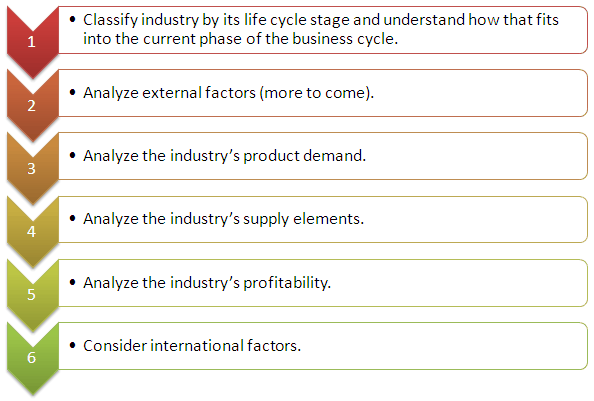Industry Analysis
This article will describe elements of industry analysis beyond Porter’s Five Competitive Forces.
Sample Steps for an Industry Analysis

Industry Life Cycle
Industries tend to follow a natural progression which can be outlined as follows:

1) Pioneer Stage: a high degree of uncertainty at this point. The product is unproven and cash flow is most likely negative, but future growth prospects are high. Investors face a high risk/high reward situation with companies in the Pioneer Stage.
2) Growth Stage: now sales and profits are increasing. The product is gaining acceptance, but total market size potential is still not fully known. Star equity analysts discover growth industries ahead of the herd.
3) Mature Stage: the industry has become saturated and growth rate will slow to the rate of general economic growth. Growth companies can still be found within mature industries, as they may be improving the product’s quality or acquiring competitors.
4) Decline Stage: demand for the industry’s product is contracting and the surviving firms fight for market share. Profit margins will shrink and some firms will fail or leave the industry. Stronger firms may anticipate product decline and diversify their operations.
Industry Classifications and Business Cycle Reactions
While industries can be classified by their lifecycle phase, they must also be considered within the context of how they react to the business cycle.
The table below describes industries by business cycle:
| INDUSTRY TYPE | BUSINESS CYCLE TRAITS | LIFECYCLE TRAITS |
|---|---|---|
| Growth Industry | Grows regardless of business cycle phase. | Moving from pioneer phase to growth phase; products commonly employ new technology. |
| Defensive Industry | Perform in a stable manner throughout the business cycle, with growth during economic expansion, but small hurts to profitability in a recession. | Defensive firms commonly come from mature industries. Healthcare is considered by some to be a defensive industry. |
| Cyclical Industry | Company profits will fluctuate with the business cycle. |
External Factors
Factors outside the industry and its companies can influence behavior and profitability. External factors include:
-
Technology: this can be a positive or negative as technology can provide an industry or company with a protective moat when it is difficult to replace or a competitive threat when a mature industry’s technology is subject to replacement by new innovation.
-
Government Involvement: like technology, government behavior can protect or hinder industry performance.
-
Regulations for health and safety can increase industry operating costs, which hurts profitability. Alternatively, these same regulations may lead to the development of new industries as a new supplier need is created, which did not previously exist.
-
Taxes and subsidies can be deployed to force companies to offset negative externalities created by their products (ex. pollution) or to support domestic companies in the face of international competition.
-
Foreign Factors: when a key component in an industry’s supply chain comes from overseas, the industry is susceptible to foreign influence. This creates risk within the industry that might not be easy to mitigate.
-
Demographic Changes: demand for an industry’s product can be affected by changes in the age and income distribution of the industry’s target geographic market. For example, as the U.S. population continues to age, new opportunities for firms in the healthcare industry will emerge.
-
Social Changes: lifestyle preferences evolve over time and the changes impact industries. Some social changes take long period of time to occur, while changes in fashion are more short term and unpredictable.


